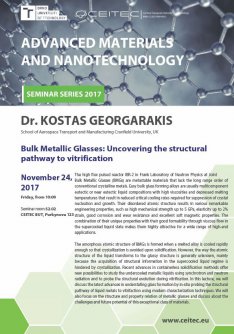Bulk Metallic Glasses (BMGs) are metastable materials that lack the long-range order of conventional crystalline metals. An easy bulk glass forming alloys are usually multicomponent eutectic or near eutectic liquid compositions with high viscosities and depressed melting temperatures that result in reduced critical cooling rates required for suppression of crystal nucleation and growth. Their disordered atomic structure results in various remarkable engineering properties, such as high mechanical strength up to 5 GPa, elasticity up to 2% strain, good corrosion and wear resistance and excellent soft magnetic properties. The combination of their unique properties with their good formability through viscous flow in the supercooled liquid state makes them highly attractive for a wide range of high-end applications.
The amorphous atomic structure of BMGs is formed when a melted alloy is cooled rapidly enough so that crystallization is avoided upon solidification. However, the way the atomic structure of the liquid transforms to the glassy structure is generally unknown, mainly because the acquisition of structural information in the supercooled liquid regime is hindered by crystallization. Recent advances in containerless solidification methods offer new possibilities to study the undercooled metallic liquids using synchrotron and neutron radiation and to probe the structural evolution during vitrification. In this lecture, we will discuss the latest advances in understating glass formation by in-situ probing the structural pathway of liquid metals to vitrifaction using modern characterization techniques. We will also focus on the structure and property relation of metallic glasses and discuss the challenges and future potential of this exceptional class of materials.








